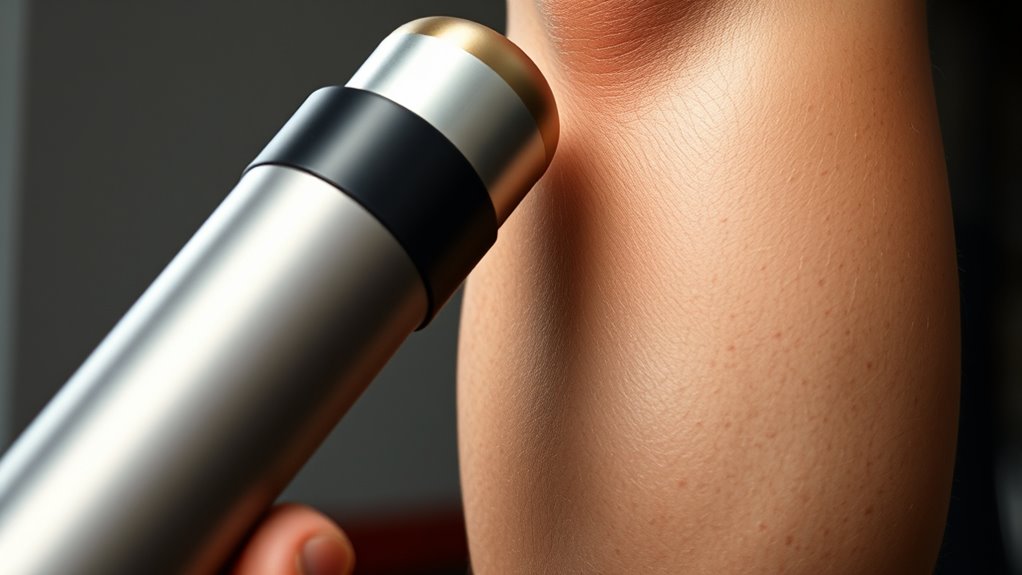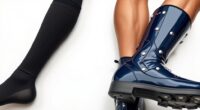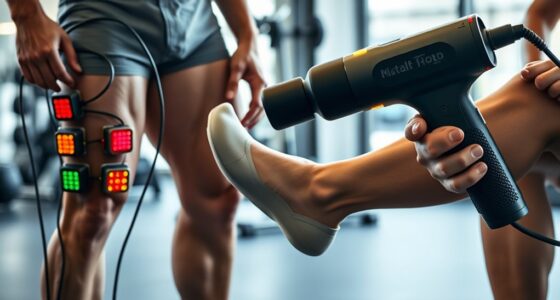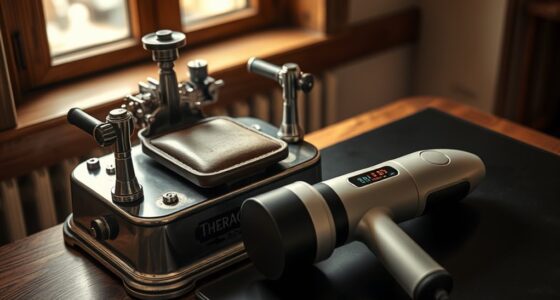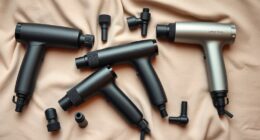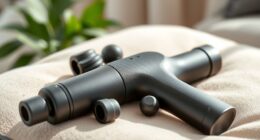Percussion massage guns reduce muscle soreness by sending rapid vibrations that stimulate your muscle fibers, improve blood flow, and trigger cellular responses that promote healing. These pulses help break up tight tissues, remove metabolic waste like lactic acid, and relax tense muscles. By targeting specific trigger points, they relieve tension and enhance circulation. If you want to discover how these mechanisms work together to speed your recovery, keep exploring how percussion therapy benefits your muscles.
Key Takeaways
- Percussion therapy stimulates muscle cells, promoting repair and reducing inflammation, which alleviates soreness.
- Mechanical pulses activate neural pathways that block pain signals and relax tense muscles.
- Increased blood flow from percussion helps deliver nutrients and oxygen, speeding recovery and waste removal.
- Targeted tapping releases trigger points and fascia, decreasing muscle tightness and localized pain.
- Consistent use of massage guns enhances circulation and tissue flexibility, preventing and reducing post-exercise soreness.
How Percussion Therapy Works at the Cellular Level
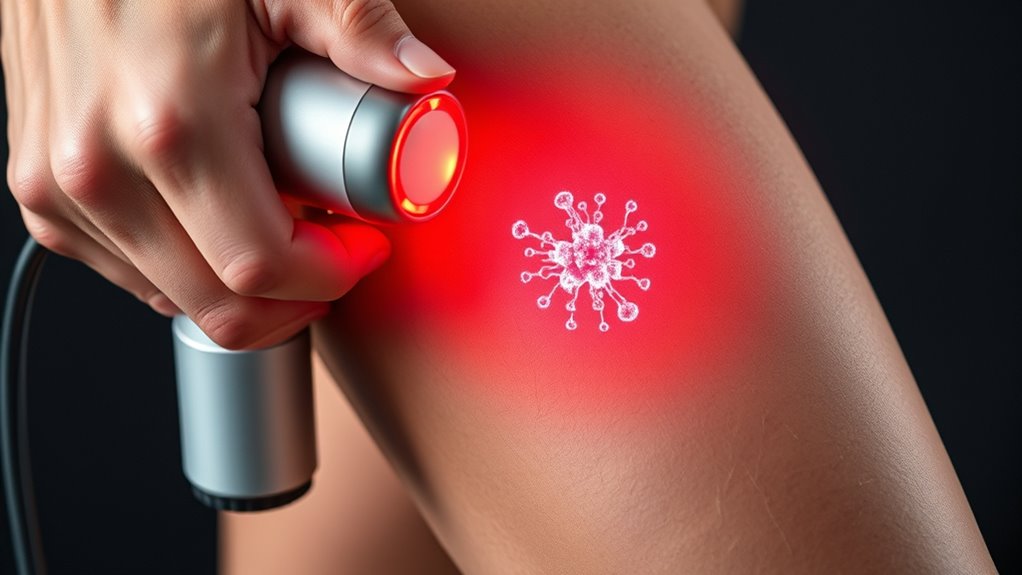
Percussion therapy works at the cellular level by stimulating your muscle cells and tissues through rapid, targeted vibrations. These vibrations promote muscle fiber stimulation, encouraging your cells to activate their natural repair processes. As the percussion device delivers quick pulses, it enhances blood flow and oxygen delivery, which are vital for cellular repair. This increased circulation helps remove metabolic waste products, reducing inflammation and soreness. By directly targeting muscle fibers, percussion therapy encourages your body to rebuild damaged tissues more efficiently. The vibrations also trigger cellular responses that support healing and recovery. Additionally, immune response can be activated through mechanical stimulation, further aiding tissue repair. Overall, this process accelerates muscle repair, reduces discomfort, and prepares your muscles for activity or recovery, making percussion therapy a powerful tool for optimizing muscle health at the cellular level.
The Role of Mechanical Pulses in Muscle Recovery
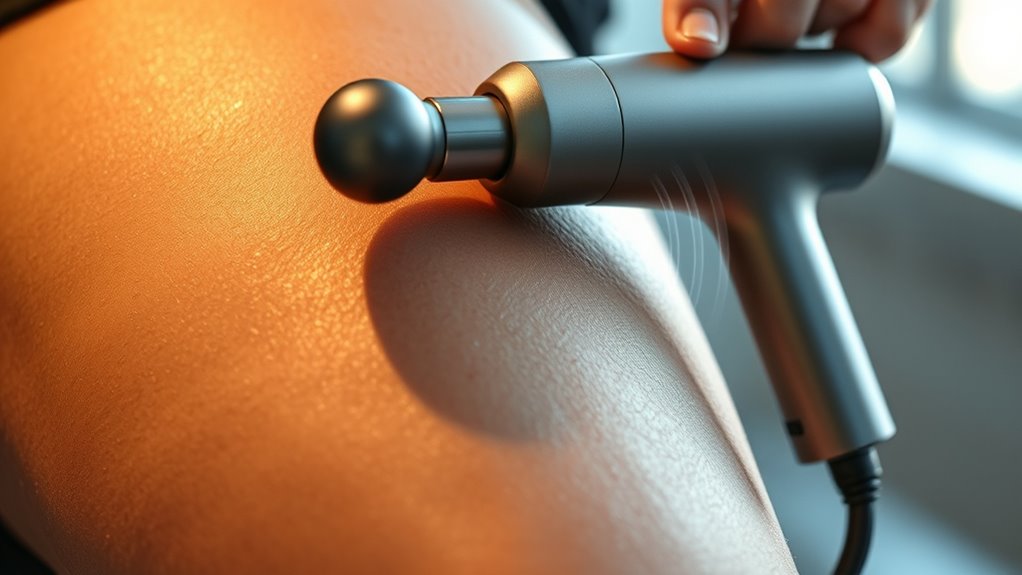
Mechanical pulses delivered by percussion massage guns play an essential role in speeding up muscle recovery by directly influencing tissue response. These pulses promote neural stimulation, which helps reset nerve signals and reduce soreness. They also aid in pain modulation by interrupting pain signals, making discomfort more manageable. Additionally, the pulses trigger three key effects:
- Enhance muscle relaxation, reducing tension and stiffness
- Activate mechanoreceptors, improving the body’s response to injury
- Stimulate the nervous system to optimize recovery processes
Furthermore, these mechanical pulses can positively impact muscle regeneration, supporting tissue repair and overall recovery efficiency.
Effects of Massage Guns on Circulation and Lactic Acid Removal
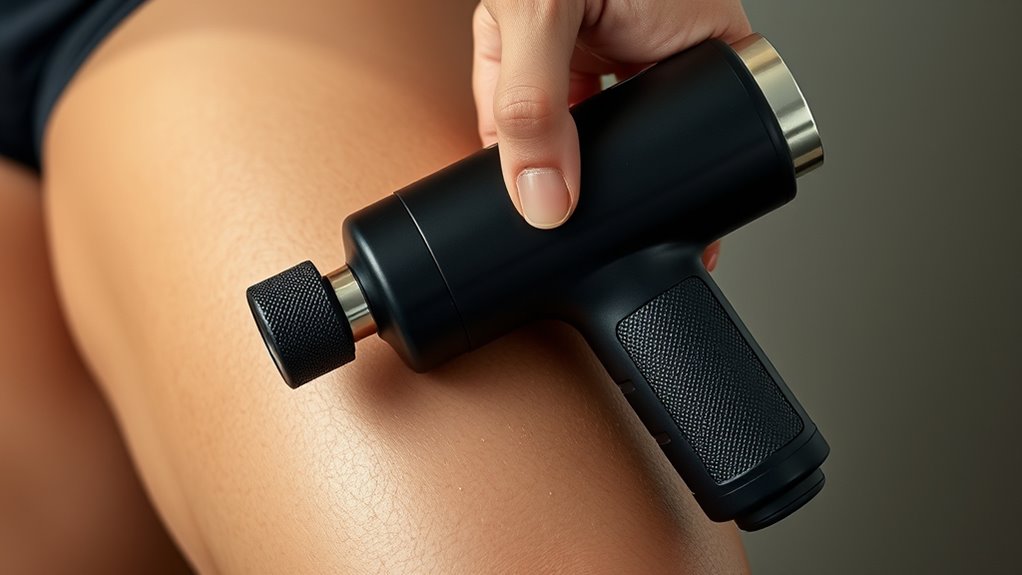
When you use a massage gun, it actively stimulates blood flow in the targeted muscles, which can considerably improve circulation. Enhanced blood flow delivers more oxygen and nutrients, supporting faster recovery. This increased circulation also helps your body efficiently remove waste products like lactic acid, a common contributor to muscle soreness. By breaking up tight muscle tissues and promoting better circulation, massage guns accelerate the clearance of lactic acid from your muscles. This process reduces the feeling of fatigue and soreness after intense activity. Improved blood flow not only aids recovery but also prepares your muscles for future workouts. Regular use of massage guns can therefore help maintain healthier circulation and minimize muscle discomfort caused by lactic acid buildup. Additionally, the tuning of muscles through massage gun therapy can optimize their responsiveness and overall performance.
The Benefits of Targeted Tapping for Muscle Tension Relief
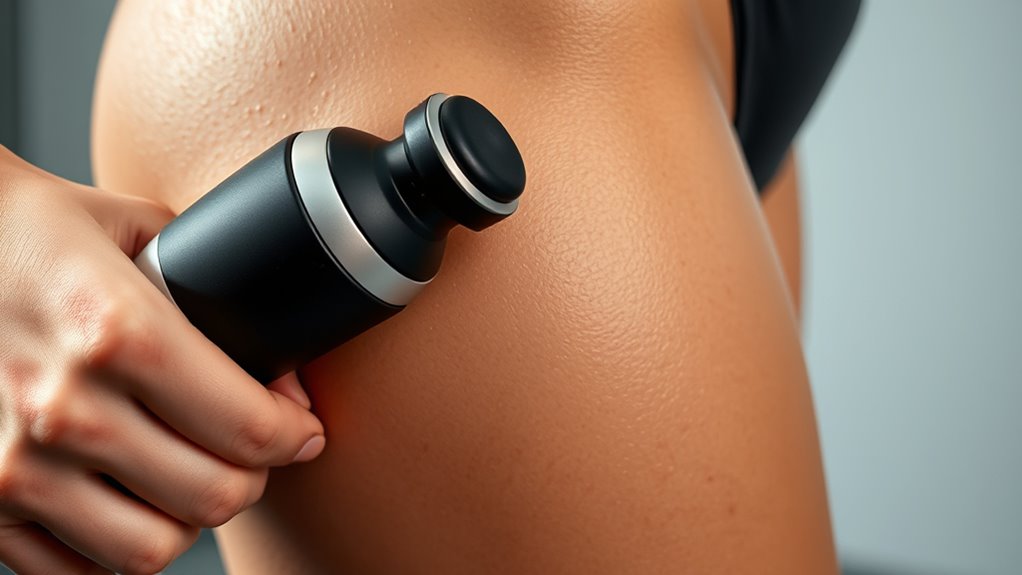
Targeted tapping with a massage gun offers a focused way to release muscle tension and reduce discomfort. It helps identify and relax trigger points—tight knots that cause pain and limit movement. By applying precise pressure, you can achieve fascia release, loosening the connective tissue that encases muscles. Here are three benefits:
- Relieves specific trigger points that cause localized pain.
- Improves fascia flexibility, reducing overall muscle tightness.
- Enhances blood flow directly to tense areas, supporting quicker recovery.
- Incorporating automation in healthcare can optimize treatment protocols for better muscle recovery outcomes.
This targeted approach allows you to focus on problem spots, providing immediate relief. It’s an effective way to break down knots and promote muscle relaxation, making your recovery more efficient and comfortable.
Optimizing Massage Gun Use for Effective Muscle Soreness Reduction
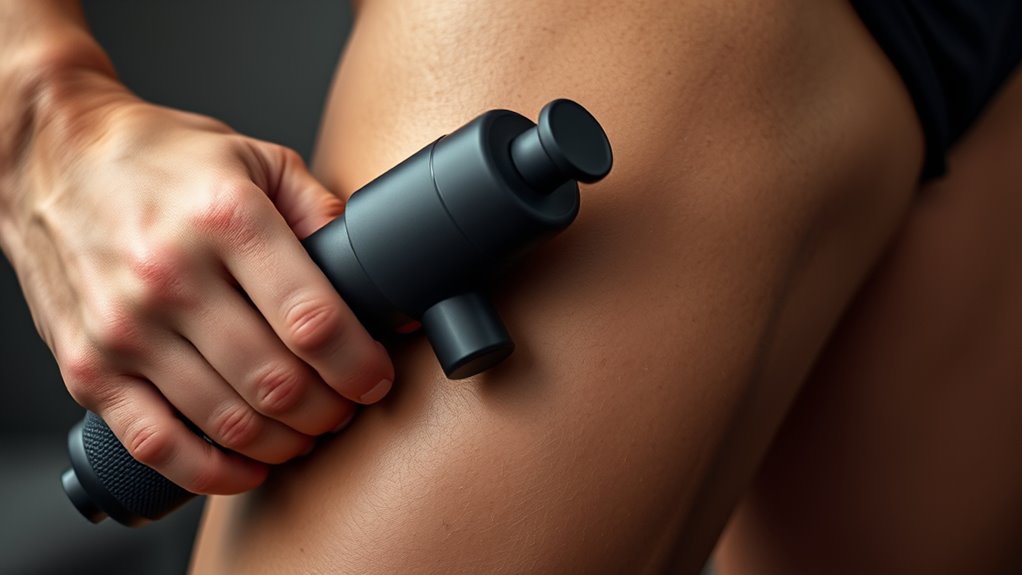
To effectively reduce muscle soreness with a massage gun, it’s essential to develop a strategic approach that maximizes its benefits. Focus on targeting trigger points, which are tight knots causing pain and discomfort. Applying the massage gun directly to these areas helps break up adhesions and alleviates tension. Incorporate fascia release techniques by slowly moving the device along the fascia—the connective tissue surrounding muscles—to promote flexibility and reduce tightness. Adjust the intensity and duration based on your comfort level, avoiding excessive pressure that might cause bruising. Concentrate on problem areas post-workout or when feeling sore. Consistent, deliberate use guarantees you optimize recovery, prevent future soreness, and enhance overall muscle health.
Frequently Asked Questions
Are Massage Guns Suitable for All Age Groups and Fitness Levels?
You might wonder if massage guns suit everyone. Generally, they’re age appropriate and adaptable to different fitness levels, but caution is key. If you’re young or elderly, or have health issues, check with a healthcare professional first. For fit individuals, massage guns can boost recovery and flexibility. Always start with lower settings and monitor how your body responds, ensuring safe and effective use tailored to your age and fitness adaptability.
How Often Should I Use a Massage Gun to Prevent Soreness?
Did you know that using a massage gun just 2-3 times a week can notably reduce muscle soreness? For soreness prevention, you should aim for consistent usage frequency, around every other day or as needed after workouts. Avoid overusing it, as excessive use might cause irritation. Listen to your body, and adjust the frequency accordingly to keep muscles relaxed and prevent soreness effectively.
Can Massage Guns Help With Chronic Muscle Pain or Injuries?
You might find that massage guns can aid in managing chronic pain and supporting injury recovery techniques. They help increase blood flow, reduce muscle tightness, and improve flexibility, which can alleviate discomfort over time. However, it is crucial to use them carefully and consult a healthcare professional for persistent pain or injuries. Incorporating massage guns as part of your chronic pain management plan can enhance your overall recovery process and promote muscle health.
What Safety Precautions Should I Take When Using a Massage Gun?
When using a massage gun, you should focus on safety precautions like maintaining equipment properly and applying proper technique. Always check the device for damage before use and keep it clean to prevent infections. Use the massage gun on muscles gently, avoiding bones and joints, and don’t press too hard. Limit sessions to avoid overuse, and consult a healthcare professional if you experience pain or discomfort.
Do Different Percussion Frequencies Target Specific Muscle Groups?
You might wonder if different percussion frequencies target specific muscle groups. The answer is yes; varying the frequency allows for muscle targeting and better frequency optimization. Higher frequencies work well for deep tissue and larger muscles, while lower frequencies are suitable for more sensitive areas or smaller muscles. Adjusting the percussion speed helps you customize your massage, ensuring effective recovery and reduced soreness tailored to each muscle group’s needs.
Conclusion
Think of your muscles like a busy highway, clogged with traffic and debris. Using a massage gun is like opening up lanes, helping the flow of circulation and clearing out lactic acid. I once tried it after a tough workout and felt instant relief—like hitting reset on a jammed traffic jam. With consistent use, you’ll keep your muscle traffic moving smoothly, speeding up recovery and reducing soreness so you’re ready for your next challenge.
